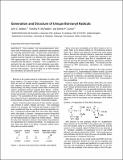Generation and structure of unique boriranyl radicals
Abstract
Three-member ring boracyclopropanes (boriranes) with N-heterocyclic carbene substituents were prepared by a recently discovered route. H atoms were selectively abstracted from the boron atoms by t-butoxyl radicals and this enabled boriranyl radicals to be detected and characterized by EPR spectroscopy for the first time. Their EPR parameters indicated they had planar π-character. From competition experiments, the rate constant for H atom abstraction was determined and found to be about 2 orders of magnitude less than for NHC-boranes. The B–H BDE of an NHC-borirane was estimated to be about 95 kcal mol–1.
Citation
Walton , J C , McFadden , T R & Curran , D P 2017 , ' Generation and structure of unique boriranyl radicals ' , Journal of the American Chemical Society , vol. 139 , no. 46 , pp. 16514-16517 . https://doi.org/10.1021/jacs.7b10788
Publication
Journal of the American Chemical Society
Status
Peer reviewed
ISSN
0002-7863Type
Journal article
Description
J.C.W. thanks EaStCHEM for financial support. T.R.M. and D.P.C. thank the US National Science Foundation for grant CHE-1660927.Collections
Items in the St Andrews Research Repository are protected by copyright, with all rights reserved, unless otherwise indicated.

